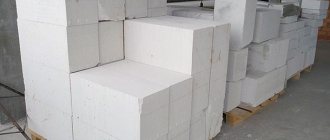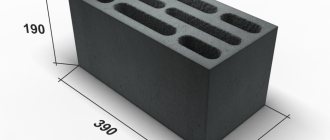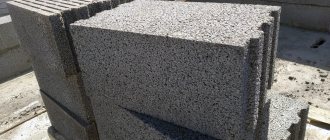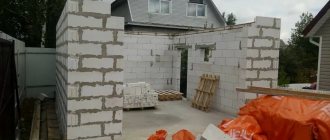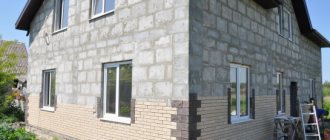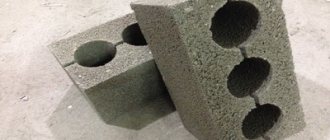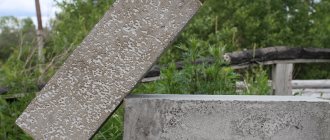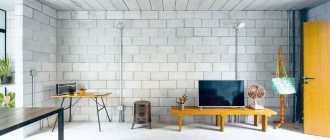Arbolite blocks
– a building material with a wide range of useful properties that is gaining popularity. To better understand where and how best to use it, you need to learn about its properties and characteristics, advantages, and application features. In this case, it will be possible to make full use of the positive properties of wood concrete and minimize the influence of negative ones.
Arbolite blocks and their production
Wood concrete is a type of large-porous lightweight concrete, the filler of which is wood chips. It is bound into a monolithic structure with concrete - cement paste. The quality of the stages of the production process of wood concrete blocks is the key to the least number of defects in the finished material.
Wood concrete is used in construction in the following forms:
- large-format masonry blocks;
- hollow blocks;
- thermal insulation boards;
- mixtures for pouring enclosing structures.
The most widely used are masonry blocks, and they are often what is meant when talking about wood concrete. The most popular standard size of wood concrete blocks is 500x300x200 mm, but now manufacturers offer products of other sizes.
Despite the fact that it is not difficult to make wood concrete blocks, there are strict regulatory requirements that must be followed if the word “arbolite” is used in the product name. Documentation includes:
- GOST 19222-84 “Wood concrete and products made from it. General technical conditions".
- SN 549-82 “Instructions for the design, manufacture and use of structures and products made of wood concrete.”
Reviews from masters
On the Internet you can find many reviews about wood concrete. Almost all users write about the good thermal insulation and sound insulation parameters of this material. Also, most of them note the lightness of the blocks, thanks to which one person can handle the construction of the house.
Most craftsmen note that all year round, both in sultry heat and severe frosts, the optimal temperature inside the house is maintained.
Among the dissatisfaction, one can note the high consumption of plaster.
If you look at the reviews of craftsmen in general, almost all of them emphasize the positive aspects and qualities of this material and recommend using wood-concrete blocks for construction purposes.
Block composition
Arbolite blocks are usually made from the following materials:
- wood chips;
- water;
- cement;
- chemical additives.
Wood chips
The strength of the finished product directly depends on the caliber of wood chips used. To obtain wood concrete with properties that meet the standards, you need to use wood chips, the dimensions of which are specified in GOST, which means that the particle size should not exceed 40x10x5 mm.
The best properties are found in blocks with chip sizes in the following ranges:
- length – up to 25 mm;
- width – from 5 to 10 mm;
- thickness – from 3 to 5 mm.
It is important to use wood chips for the mixture with cement that do not contain foreign impurities, such as bark, tree leaves or soil. Sawdust, wood shavings, straw, tyrsa and other similar materials are not suitable for the production of high-quality wood concrete. Despite this, it is considered acceptable, although not desirable, to contain up to 10% tree bark and up to 5% foliage. This percentage of impurities does not have a significant effect on the final characteristics of the wood concrete.
Often the reason for low-quality material lies in the fact that wood concrete is produced at non-core enterprises: often these are wood processing enterprises, where impurities get into it when harvesting wood chips.
When preparing wood chips, specialized enterprises usually use powerful equipment: roller crushers, which are capable of creating wood chips of the required caliber.
The type of wood from which the chips are made is not important for the final consumer, however, according to the wood concrete manufacturing technology, it affects the dosage of mineralizers and the degree of compaction. For example, when using larch chips, twice as many mineral additives are required as for other coniferous species. The most common wood chips are spruce and pine, but deciduous trees are rarely used.
Chemical additives
Wood contains sugar compounds, which are an obstacle to the complete adhesion of the binder component (cement paste) with wood particles.
There are two main ways to increase adhesion between the components of wood concrete:
- wood raw materials are dried in advance for several months;
- The surface of the chips is subjected to mineralization in a special chemical solution.
However, the best binding of components can be achieved by combining the above methods. At the same time, they help solve some other important problems in the manufacture of wood concrete, such as increasing biostability, as well as reducing the moisture permeability of the finished material.
Among the chemical components used for the mineralization of wood chips are substances that meet the standards: calcium chloride (GOST 450-77), liquid glass (GOST 13078-67), silicate block (GOST 13079-67), alumina sulfate (GOST 5155-74) , lime (GOST 9179-77).
Water
In order for the finished wood concrete to have the full range of declared properties, an aqueous solution of mineralizers is prepared in advance, using the following proportions of components:
| ADDITIVE | CACL2 | AL2(SO4)3 | AL2(SO4)3+ CA(OH)2 |
| Consumption per 1m3 of wood concrete, kg | 12 | 12 | 8+4 |
At the first stage of the process, the wood chips are placed in a special mixer, where water with a mineralizer dissolved in it is evenly distributed over its surface. Gravity concrete mixers are not used for this, since it is impossible to achieve the proper degree of homogenization in them. The chips are mixed with the mineralizing solution within 20 seconds. At the second stage, cement is added to the mixture, mixing with it lasts 3 minutes.
Cement
The type of cement used plays a big role in the strength of the finished material. According to the standards for the production of wood concrete, it should be no lower than 400, however, even immediately after leaving the factory, cement often has time to lose its grade during storage, therefore, in the production of wood concrete structural materials, it is desirable to use grade 500 cement.
Wood chips: how to get or where to buy
The best wood chips for wood concrete are made from pine and spruce. You can also use larch, but when mixing it is necessary to double the amount of chemical additives. Among hardwoods, GOST allows the use of aspen, beech, birch, and poplar. The remaining requirements are:
- Maximum dimensions 40*10*5 mm. The optimal parameters of wood chips have been established experimentally: length is about 25 mm, width is 5-10 mm, thickness is 3-5 mm. The strongest wood concrete blocks are obtained from such raw materials.
- The amount of bark should not exceed 10%.
- There should be no dust, sand, soil, or foreign impurities. The chips are removed from small fractions, dust and sand using a sieve, and large foreign inclusions are removed manually (often pieces of soil or stones).
- There should be no visible mold or rot.
Example of wood chips
The best wood chips come from lump waste wood. It is first passed through chippers and then crushed in a hammer crusher. The following mechanisms can be used for this:
- Disc chippers with adjustable knives. Not all of them can be adjusted to produce chips of the required size, but the sizes will be close.
- Rotary knife crushers. They produce narrow and not wide chips, and the length is adjustable. That is, this is a good option. There is only one “but”: there are a lot of knives and if used for a long time, they need to be changed or welded (they don’t sharpen). On the plus side, we add that crushers of this type can be used for re-crushing process chips obtained during the first crushing (after reconfiguration).
- Shredders or roller grinders. This is expensive equipment (about 1 million rubles), mostly imported, but it is excellent because it is manufactured for specific chip sizes.
If making wood chips yourself is not an option, you can buy it. If possible, you can negotiate at the factory where wood concrete is produced. Just check the chip parameters. If there is none nearby, you can take chips from under the calibration machines. Some of them can be adjusted so that the chips are not thick.
Arbolite blocks and the process of their formation
The blocks must be completely formed no later than 15 minutes after mixing the components. Mechanical means are often used during formation. There are several types of formation:
- manual formation without vibration;
- manual forming with vibration;
- production on a vibrating machine;
- production on a vibrating machine with a weight.
Mechanization of the process makes it possible to achieve greater stability of mechanical parameters and linear dimensions, and to obtain higher-quality wood concrete blocks.
In handicraft production, the mixture for blocks often turns out to be too liquid, and the blocks have to be kept in the formwork until thickening occurs. In the general case, subject to production technology, the molds are removed from the blocks without holding, and the raw blocks are left to dry on the workshop floor or on a special removable pallet.
The compaction of wood concrete blocks is not carried out with the aim of increasing their density: the main goal is to achieve the most uniform distribution of wood chips in the cement paste, so that the orientation of its particles is arbitrary and the surface is completely covered. Even with the same composition, wood concrete blocks may have different characteristics if they have been subjected to different compaction. Vibration can lead to cement precipitation, so it is used sparingly for compaction. When the blocks are compacted, there is no deformation of the chip grains, only the area of their mutual contact and orientation in space changes. Cement acts as an adhesive, and with different degrees of compaction, the thickness of the layer of cement adhesive covering the chip particles changes. Therefore, after compaction, the block size does not change.
Mineral binder
There is no way you can make a solution with your own hands without a binder. It makes wood concrete blocks durable and suitable for masonry. Portland cement grade M400, M500 or even higher is used as a binder.
Its consumption depends on the type of aggregate, particle size, cement brand, characteristics, etc. To get a little guidance, you can determine the consumption this way: factor 17 must be multiplied by the required brand of wood concrete. For example, you need to prepare a solution, grade 15 (B1). In this case, 1 m3 of wood concrete will require 255 kg of cement.
Precision in the manufacture of wood concrete
It is very important that production is carried out in accordance with GOST, and deviations in the dosing of components are no more than a few percent. If there is insufficient amount of water in the mixture, not all the cement will be wetted, and as a result of its excess, the strength of the product may be reduced, it will become excessively flexible, and the time during which the drying block will initially set will increase.
The optimal proportions of mineralizing substances are selected experimentally, since the standards indicate dosages for chips of a certain caliber at a humidity of 25%. Correctly selected proportions will ensure a long service life of the finished blocks.
It is also important to select the water temperature for the mineral mixture: it must be at least 15 °C, so in cold weather the water is heated using mechanical or chemical heating (with a CaCl2 mineralizer).
A little history, or Everything new is well forgotten old
Wood concrete is not a new material, but it was undeservedly forgotten in the 90s.
GOST standard 19222-84 for wood concrete was approved in 1984, although already in the 60s they began to use it to build buildings for a polar station at the South Pole. At that time, more than 100 factories produced wood concrete throughout the Union. To this day, in the Arkhangelsk region, apartment buildings made of arbolite slabs built in the 70s and 80s have been preserved. According to reviews from residents, these houses are very warm, despite the venerable age of the houses. This suggests that this building material is durable and does not lose its thermal insulation properties over time.
The progenitor of wood concrete can rightfully be considered one of the oldest building materials - adobe. In those days, clay was used as a substitute for cement, and straw was used instead of wood filler. The idea of mixing binders with natural fillers led to the creation of wood concrete.
During Soviet times, the timber industry actively developed throughout the Union, leaving an incalculable amount of unused production waste. It was decided to find a useful use for logging waste in the production of wood concrete. This is how wood concrete came to the Union, and is now actively used in modern construction.
An analogue of Durisol wood concrete was patented in Switzerland more than 60 years ago and is still successfully used in Western Europe not only in low-rise construction, but also for industrial buildings and cottages in the premium segment. Europeans value it for its naturalness.
Physical properties of wood concrete
One of the most important physical properties of wood concrete is its density. According to the purpose of finished products, the material is usually divided into two types:
- thermal insulation;
- structural.
Wood concrete with a density not exceeding 500 kg/m3 is used as thermal insulation. Such material can be used wherever the load is distributed to other structural elements, for example, even as thermal insulation of external walls, if the weight of the roof and ceilings is carried by other load-bearing parts.
Structural wood concrete usually has a density in the range from 550 to 700 kg/m3, but there are products with extremely high densities up to 850 kg/m3. Despite their superior strength, such samples are inferior to lighter ones in thermal insulation properties. The density of the block is measured after it has completely dried.
For the manufacture of walls, it is possible to use cast wood concrete; their final density will be about 300 kg/m3, while the load-bearing capacity of such walls will correspond to stone ones, which have a density of 550 kg/m3.
Composition recipe and consumption of components per 1 cubic yard of wood concrete
The proportions for mixing all the components together are as follows:
cement: filler: water with added chemicals - 1: 1: 1.5.
The table shows approximate values for the consumption of cement, wood chips and additives depending on the density of the block per 1 m3 of finished product:
| Purpose | Block strength class | Chips, kg | Cement, kg | Calcium chloride, kg | Water, l |
| Thermal insulation of external fences | B0.75 | 180…190 | 280…300 | 8 | 330…360 |
| Thermal insulation of roofs and floors | 1,0 | 200…210 | 300…330 | 8 | 360…390 |
| Outbuildings, one-story houses | 1,5 | 220…230 | 330…360 | 8 | 390…430 |
| Two-story cottages | 2,5 | 240…250 | 360…390 | 8 | 430…480 |
To make blocks, you need well-dried wood chips, cement grades from M300 and higher - for thermal insulation, from M 400 - for wall stones.
Chemical additives make up 2–4% of the total mass. The following proportions of additives are used:
- calcium chloride and aluminum sulfate in a ratio of 1:1 - less than 4% by weight of cement;
- calcium chloride and sodium sulfate in a 1:1 ratio - less than 4%;
- aluminum chloride and aluminum sulfate in a 1:1 ratio – less than 2%;
- calcium chloride and aluminum chloride in a ratio of 1:1 - less than 2%.
Sodium or potassium silicates are used in similar proportions.
Briefly about the technology and recipe. Chips and cement are mixed until a homogeneous composition, and it is important that the cement does not settle down the container. Then the mixture is mixed with water and dissolved chemical additives.
The resulting arbocrete is poured into molds within half an hour.
In industrial production, vibrating tables and split molds are used; in construction production, the mixture is prepared in a concrete mixer and poured into the molds layer by layer with compaction. The mixture hardens in the mold within 24 hours , then the blocks are put out for ripening.
When making blocks with your own hands, the main thing is to maintain proportions and use high-quality initial components.
Block Strength
The main characteristic of blocks used to classify their load-bearing capacity is compressive strength, which gives the product a class and brand. It is determined by the average test results performed on the entire batch of samples. The class of wood concrete determines its guaranteed strength, and its presence in a batch means that at least 95% of its samples correspond to it.
| DENSITY, KG/M3 | BRAND | CLASS |
| 400 — 500 | M 5 | B 0.35 |
| 450 — 500 | M 10 | B 0.75 |
| 500 | M 15 | B 1.0 |
| 500 — 650 | — | B 1.5 |
| 500 — 700 | M 25 | B 2.0 |
| 600 — 750 | M 35 | B 2.5 |
| 700 — 850 | M 50 | V 3.5 |
It is customary to establish a relationship between brand and class using coefficients of variation. The gap between these characteristics can tell a lot about the peculiarities of the organization of production work. It is generally accepted that the smaller it is, the better the organization of work. The acceptable gap for the first category is no more than 18%, for the highest – 15%.
It usually makes sense to assign a class to large masonry stones, which include wood concrete blocks, while this concept is not applicable to small brickwork.
There are recommendations for using classes depending on the task. So, for load-bearing walls of one-story buildings (height up to three meters), materials from class B 1.0 should be used, but if the height of the walls is more than three meters - from class B 1.5. When constructing two-story and three-story buildings, blocks of classes B 2.0 and B 2.5 are needed, respectively.
Arbolite has a number of advantages in terms of strength compared to foam concrete, aerated concrete and other porous types of concrete: it is much less susceptible to cracking, since it has high bending strength (from 0.7 to 1.0 MPa), and the value of its elastic modulus can be 2300 MPa. At the same time, its compressive strength is no less - it is typical for porous concrete.
Dimensions
The most popular products are of two types:
- 500×300×200 mm.
- 500×300×250 mm.
The demand for these blocks did not appear out of the blue. It's all about the optimal size ratio:
- Length . An indicator of 500 mm allows you to erect walls that are multiples of a meter in length. Let's say for a wall of 8 m you will need 16 blocks in one row. It's comfortable. No need to saw the material.
- Width . The basic 300 mm is enough so as not to think about additional insulation of the walls. It is enough to make the masonry, as they say, “half a block”.
- Height . It all depends on the wall. If it is 2400 mm high, then the first block will do, and if it is 2250 mm, then the second wood concrete will do the job better.
Now let's move on to the sizes of specific varieties of sawdust concrete specified in GOST .
For masonry walls
As the name suggests, these blocks are used to form the foundation of the house - its walls. The traditional shape is a rectangle. There are solid ones and those with voids into which the solution can be poured for more reliable fixation. Some types have a tongue-and-groove lock. The dimensions are:
| Type | Length, mm | Width, mm | Height, mm |
| 600×400×250 | 600 | 400 | 250 |
| 600×300×200 | 600 | 300 | 200 |
| 500×300×200 | 500 | 300 | 200 |
| 500×300×250 | 500 | 300 | 250 |
| 500×300×142 | 500 | 300 | 142 |
| 500×250×142 | 500 | 250 | 142 |
| 500×350×200 | 500 | 350 | 200 |
| 500×150×200 | 500 | 150 | 200 |
| 410×300×200* | 410 | 300 | 200 |
* This species is called “northern”. It is used in cold regions. Place the bandage “in one block”. 410 thick .
Permanent formwork
Such wood concrete is used for the construction of monolithic walls and insulation of existing ones, for example, reinforced concrete ones. There are blocks with and without thermal insert. The shape is usually rectangular, with internal voids. Dimensions:
| Type | Length, mm | Width, mm | Height, mm |
| 1000×380×250 | 1000 | 380 | 250 |
| 1000×220×250 | 1000 | 220 | 250 |
| 1000×250×250 | 1000 | 250 | 250 |
| 900×380×250 | 900 | 380 | 250 |
| 900×250×250 | 900 | 250 | 250 |
| 830×380×250 | 830 | 380 | 250 |
Acoustic
Designed for thermal and noise insulation. They are used to make interior partitions. This is an ideal solution if the house is located near railway tracks or highways with high traffic. Dimensions:
| Type | Length, mm | Width, mm | Height, mm |
| 1000×250×250 | 1000 | 250 | 250 |
| 500×150×200 | 500 | 150 | 200 |
| 500×250×142 | 500 | 250 | 142 |
| 500×250×150 | 500 | 250 | 150 |
At the same time , GOST imposes restrictions on the maximum permissible deviations (no more):
| Description | Deviation, mm |
| Length | 15 |
| Width | 15 |
| Height | 13 |
| Partition thickness | +3 |
| Diagonal length difference | 4 |
Thermal conductive properties of wood concrete
Another very important parameter of wood concrete is its thermal conductivity. Its dependence on the density of the material is illustrated by the graph:
There is a thickness recommended by GOST for enclosing structures made of wood concrete. For moderate latitudes it is 38 cm, but in practice this value is somewhat overestimated, and very often in the construction of residential buildings they use blocks with dimensions of 500x300x200 mm, laying them out in one row. If there is external and internal finishing of such walls, a normal temperature will be maintained inside the room.
A common type of additional thermal insulation is perlite-containing warm plaster systems (thickness 1.5 - 2 cm).
When building a bathhouse and other premises in which heating occurs periodically, a special type of block masonry is often used: on edge.
How to lay wood concrete blocks
Wood concrete is wood chip concrete, the strongest of lightweight concretes based on organic filler. Mixtures can be used for laying blocks:
- Cement-sand. Not the best alternative for the construction of residential buildings due to high heat conductivity. But in cases where heat preservation is not a priority (building a garage, shed), the use of this mixture is acceptable.
- Perlite mixture is a finely dispersed volcanic rock, blocks based on which retain heat well and are more acceptable in residential construction.
- The ideal option is considered to be adhesive for cellular concrete - durable and economical, working with this composition is easier than previous options.
Step 1
Laying waterproofing - most often 2 layers of roofing felt - on the foundation (this step protects against moisture getting into the blocks). Lay the material 10-15 cm wider than the thickness of the future walls.
Step 2
Start installation from the corners. Using a trowel, apply the masonry mortar, the layer thickness is about 6 mm (part of the composition will go into the cavity). Check the correct level and, if necessary, adjust the block using a rubber mallet.
Step 3
Set the installation level for the entire row: this is very simple to do with the help of a string stretched between the blocks from the outside.
Step 4
Apply the solution to the vertical edge from the end, install the second block tightly into the joint, and then follow it according to the same principle with the next one.
Continue this algorithm of actions until the end of the row. If you need to adjust the block to size, use a saw and immediately treat the cut area with an antiseptic compound suitable for wood. After laying the row, the basic rule is to take a break for several hours (at this time the solution will set).
Step 5
Laying reinforcing mesh on blocks of the finished row. Its further use is mandatory every 3-5 rows.
Step 6
Continue installation, applying the solution to the horizontal surface and to the end parts. Installation involves bandaging and periodic monitoring of the structure level. After installing the first row, it is not necessary to start from the corners.
One of the undeniable advantages of wood concrete blocks is the ability to saw them if necessary. It is almost impossible to accidentally damage such building materials. When cutting where chips are exposed, treatment with an antiseptic is required to prevent hidden problems in the future - the formation of mold and rot. A house made of wood concrete does not need a frame, unlike construction from materials that require shrinkage. The unpretentiousness of the blocks when stored in winter is also a significant plus.
The ability to make building material with your own hands is the main characteristic that distinguishes it from other types of blocks.
If you weigh all the pros and cons when choosing, based on reviews from real home owners, then positive opinions will still prevail. People already living in these houses note good thermal insulation, which is a significant advantage for the harsh Russian winters.
